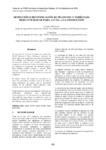Mostrar o rexistro simple do ítem
Detección e identificación de peatones y vehículos mediante radar para ayuda a la conducción
| dc.contributor.author | Viadero Monasterio, Fernando | |
| dc.contributor.author | Pérez-Oria, Juan | |
| dc.contributor.author | Alonso-Rentería, Luciano | |
| dc.date.accessioned | 2020-02-07T10:12:45Z | |
| dc.date.available | 2020-02-07T10:12:45Z | |
| dc.date.issued | 2018 | |
| dc.identifier.citation | Viadero Monasterio, F., Pérez Oria, J., Alonso Rentería, L. Detección e identificación de peatones y vehículos mediante radar para ayuda a la conducción. En Actas de las XXXIX Jornadas de Automática, Badajoz, 5-7 de Septiembre de 2018 (pp.932-936). DOI capítulo: https://doi.org/10.17979/spudc.9788497497565.0932 DOI libro: https://doi.org/10.17979/spudc.9788497497565 | es_ES |
| dc.identifier.isbn | 978-84-09-04460-3 (UEX) | |
| dc.identifier.isbn | 978-84-9749-756-5 (UDC electrónico) | |
| dc.identifier.uri | http://hdl.handle.net/2183/24864 | |
| dc.description.abstract | [Resumen] El desarrollo de sistemas de ayuda a la conducción, ADAS (Advanced Driver Assistance Systems), ha dado lugar a un significativo descenso en el número de accidentes. Los fabricantes de automóviles han desarrollado sistemas para facilitar la labor al conductor en circulación a altas velocidades o avisar al conductor de situaciones de inminente peligro, bien mediante señales visuales o sonoras. Estos sistemas presentan el inconveniente de la dependencia de la respuesta al estímulo por parte del conductor. El objetivo básico del trabajo ha consistido en la detección automática, mediante técnicas de radar y redes neuronales, de cuerpos que se encuentren delante de un vehículo, tanto vehículos como peatones, para aumentar la seguridad. Puede señalarse que aproximadamente el 85% de las mediciones realizadas son identificadas correctamente por la red neuronal. La información será utilizada para avisar al conductor o para la actuación automática sobre el freno y la dirección del vehículo, para evitar la colisión. | es_ES |
| dc.description.abstract | [Abstract] The development of systems for driving assistance, ADAS (Advanced Driver Assistance Systems), has led to a significant decrease in the number of accidents. Car manufacturers have developed systems to facilitate the work to the driver in circulation at high speeds or warn the driver of situations of imminent danger, either by visual or audible signals. These systems have the drawback of the dependence of the response to the stimulus by the driver. The basic objective of the work has been the automatic detection, by radar techniques and neural networks, of bodies that are in front of a vehicle, both vehicles and pedestrians, to increase safety. It can be noted that approximately 85% of the measurements made are correctly identified by the neural network. The information will be used to warn the driver or for the automatic action on the brake and the direction of the vehicle, to avoid the collision | es_ES |
| dc.description.sponsorship | Ministerio de Economía y Competitividad; DPI-36959 | es_ES |
| dc.language.iso | spa | es_ES |
| dc.publisher | Área de Ingeniería de Sistemas y Automática, Universidad de Extremadura | es_ES |
| dc.relation.hasversion | http://hdl.handle.net/10662/8781 | |
| dc.relation.uri | https://doi.org/10.17979/spudc.9788497497565.0932 | es_ES |
| dc.rights | Atribución-NoComercial 3.0 España | es_ES |
| dc.rights.uri | http://creativecommons.org/licenses/by-nc/3.0/es/ | * |
| dc.subject | Radar | es_ES |
| dc.subject | ADAS | es_ES |
| dc.subject | Tráfico urbano | es_ES |
| dc.subject | Redes neuronales | es_ES |
| dc.subject | Urban traffic | es_ES |
| dc.subject | Neural networks | es_ES |
| dc.title | Detección e identificación de peatones y vehículos mediante radar para ayuda a la conducción | es_ES |
| dc.title.alternative | Detection and Identification of Pedestrians and Vehicles Using Radar for Driving Assistance | es_ES |
| dc.type | info:eu-repo/semantics/article | es_ES |
| dc.rights.access | info:eu-repo/semantics/openAccess | es_ES |
| UDC.startPage | 932 | es_ES |
| UDC.endPage | 936 | es_ES |
| dc.identifier.doi | https://doi.org/10.17979/spudc.9788497497565.0932 | |
| UDC.conferenceTitle | XXXIX Jornadas de Automática | es_ES |






